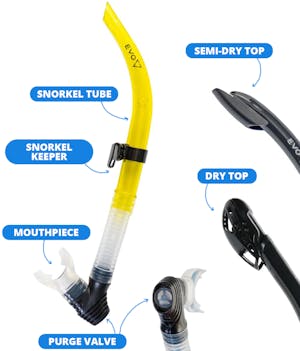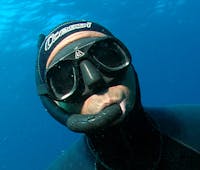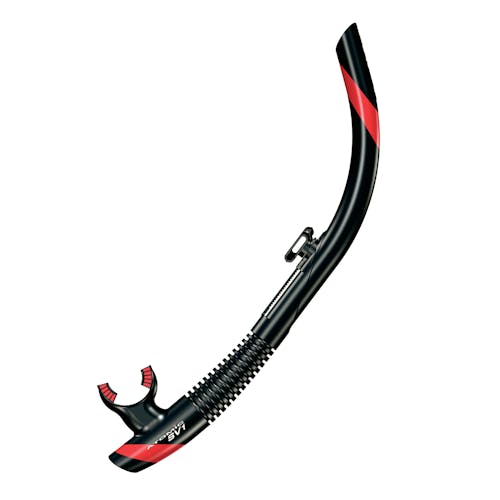Free Shipping on orders of $49+ | Signup for Direct Rewards
Free Shipping on orders of $49+ | Free Store Pickup | Signup for Direct Rewards
Free Shipping on orders of $49+ | Signup for Direct Rewards
Free Shipping on orders of $49+ | Free Store Pickup | Signup for Direct Rewards

Whether you’re snorkeling, scuba diving, or freediving, you’re definitely going to need a snorkel for your adventure. But not all are made the same, so how do you know which one will be the right one for you?
Well, let’s first understand what snorkels do. It’s pretty straightforward—they allow you to breathe when your face is submerged just below the surface of the water. This is an essential bit of equipment if you’re swimming along the surface looking below so that you don’t have to keep disrupting your experience by lifting your head for air.
Let’s look at the different parts of a snorkel, shall we? There aren’t many parts and pieces, but it’s good to know what you’re looking at and looking for when it comes to choosing one.
The largest part of a snorkel is the tube. This is the airway channel that crosses the water-to-air surface boundary making snorkeling possible. You won’t see too many different variations between tubes aside from color, material, and tube diameter. Tube diameter is generally standard and is rarely mentioned. The diameter makes a difference in drag and breathability. The wider the tube, the more difficult it is to clear and it creates more drag in the water. However, if the tube is too small, it can restrict air flow. Tube material is usually plastic, but may be made from more flexible materials. This would be important in certain sports like freediving. The color is simply personal preference, therefore should be the last feature of consideration.
The second most important piece is the mouthpiece. Most mouthpieces are made from silicone which is soft and comfortable to bite down on for extended periods of time. You may notice that some mouthpieces come in different sizes. You’ll ideally be looking for a mouthpiece size that’s best suited for your mouth. With just the tube and the mouthpiece, you have a whole snorkel. You may find you prefer the simplicity of just using these two pieces.

There are some additional parts and you may find that you prefer one that includes them. Some snorkels come with a purge valve just below the mouthpiece to make clearing water from the tube extremely easy. There are also different “tops”—dry snorkels and semi-dry snorkels. These feature a piece at the very top of the tube that’s designed to keep water from entering the tube for a more comfortable experience. Some prefer all these additional bits, while others prefer to keep things simple. These preferences tend to fall into certain categories of activity as well. Let’s dive deeper, shall we?

Starting with the simplest of snorkels and who likes to use them. J-type snorkels are most commonly used by freedivers and spearfishers. J-type are the most basic kind. When cruising the surface searching for the right spot to dive down, these get the job done. As a freediver, when it’s time to dive down you want a smooth, effortless descent. You don’t want all the extras of a purge valve and dry top to create drag in the water. When it comes to freediving snorkels, less is more. Additionally, freedivers tend to prefer a smaller mouthpiece. Note that these tubes are a touch more flexible than traditional plastic tubes. The purpose of this is so that the snorkel can move more naturally though the water alongside the diver without wobbling uncomfortably while descending and ascending.
A snorkel that has all the bells and whistles may be more appropriate for those who spend much of their adventure time snorkeling along the surface. The purge valve won’t affect the drag as much when you’re just gliding along without diving down. Additionally, when you spend most of your time at the surface, the benefits of a splash guard / dry / semi-dry top are desirable. You’ll have a much more comfortable and easy experience without having to worry about water flowing into your tube all the time. You can see all these features when you check out the ScubaPro Spectra Dry Snorkel.
When you’re just using the snorkel for a short period of time as perhaps you would for scuba diving and freediving, all the extras aren’t necessary. Though, as a diver, you may enjoy the flexibility of a corrugated lower tube like the Atomic SV2 Snorkel has. This allows the mouthpiece to drop away from the face in a relaxed and easy-to-get-to position when you’re not using it, while still attached to the mask, of course. Whether floating at the surface awaiting your dive boat to come pick you up or trading out the use of your snorkel for your regulator, you’ll find that this flexible lower tube is ideal for scuba diving snorkels. Scuba divers are more mindful of drag and lean towards a smaller style for the sake of efficiency.

All in all, you really can’t go wrong with any snorkel (even if it’s simply a hollow reed). However, we’ve learned here that there are some features that can make all the difference in the comfort and quality of your experience. Now that you have a better idea and understanding of what kind of snorkel is right for your adventure, take a look through our selection here at Divers Direct to find the right one for you.
Written by Amy Baldacci
It all boils down to two reasons: dead air space & pressure. Dead air space includes all those nooks and crannies where air sits and doesn’t get exchanged. This causes a minor build up of carbon dioxide. If the tube were longer, there would be more dead air space resulting in too much carbon dioxide for your body to safely handle. With regards to pressure when you’re underwater, even if you have a long enough snorkel to reach the surface, the average person won’t likely have enough strength to push air in and out of their lungs through that snorkel.
Yes. It is important to ensure children are using a child’s snorkel. They don’t have enough lung capacity to clear an adult size snorkel if water gets in the tube.
When properly positioned with the top of the snorkel above the water’s surface and the mouthpiece in your mouth, the snorkel tube delivers air to your lungs when you breathe in and out. This allows you to breathe while your face stays in the water.
Both have a splash guard at the top of the snorkel tube to help keep water out. With a semi-dry snorkel, some water will still get into the tube and you will need to expel that water. With a dry snorkel, there’s a device that moves to cover the opening so that no water gets into the tube.
So long as the top of the snorkel tube remains above the water line, you should be able to breathe normally. When the snorkel tube dips below the surface of the water, you’ll need to hold your breath until you surface again. Then you’ll want to blow forcefully out of the tube to clear it of any water that may have gotten inside. Breathe gently the first breath or two to avoid inhaling any remaining water that might be in the snorkel tube.
Rinse with fresh water after each use and lay it out to dry.
A snorkel is always good to have along, just in case you have to come up and swim a distance on the surface to get back to shore or your dive boat. You won’t typically need one when you’re scuba diving. For those rare occasions you do need it, you’ll be glad you have it. The most common need for them when scuba diving is with a long surface swim approach to or from your dive site. Using a snorkel rather than your regulator while you’re swimming on the surface can help to conserve air for your dive.
Most snorkels have a clip that easily attaches to your mask. If not, pick up a handy snorkel keeper and you’re all set.